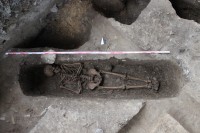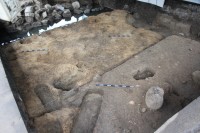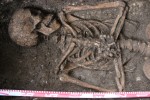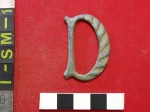 Archaeologists have discovered the remains of 17th century Christian burial on a Taiwanese island. This is the earliest European burial ever discovered in the Asia-Pacific region. Under the direction of María Cruz Berrocal from the University of Konstanz in Germany, the archaeological team has excavated the site on the island of Heping Dao in northern Taiwan since 2011. The digs have unearthed material going back as far as the island’s first human inhabitants. The evidence of early European colonization is exceptionally significant, because there is little known about the period and archaeological remains are few and far between.
Archaeologists have discovered the remains of 17th century Christian burial on a Taiwanese island. This is the earliest European burial ever discovered in the Asia-Pacific region. Under the direction of María Cruz Berrocal from the University of Konstanz in Germany, the archaeological team has excavated the site on the island of Heping Dao in northern Taiwan since 2011. The digs have unearthed material going back as far as the island’s first human inhabitants. The evidence of early European colonization is exceptionally significant, because there is little known about the period and archaeological remains are few and far between.
The settlement of San Salvador de Isla Hermosa was founded on the island as a colony of Spain in 1626. They occupied the site until 1642 when the Dutch took over. After the Dutch came the Chinese, and then Japan occupied Heping Dao until the end of World War II. Because its time as the San Salvador de Isla Hermosa colony was brief and the island passed through several hands in the centuries since, archaeologists didn’t expect to find anything from the early colonial period. The Spanish occupation was known solely from archival records; no archaeological materials associated with it had ever been found before.
 Instead, the excavations revealed a wealth of important discoveries from the early days of the colony: the foundations of a church or convent and its cemetery from the Spanish settlement. Thus far, the team has unearthed six burials and disarticulated human remains. Last November, they discovered the skeleton of an adult buried with his hands folded in the traditional Christian prayer pose. Osteological examination of the skeletal remains indicate bodies of European, Taiwanese local and maybe African origin (presumably brought to the island as slaves) were interred in the cemetery.
Instead, the excavations revealed a wealth of important discoveries from the early days of the colony: the foundations of a church or convent and its cemetery from the Spanish settlement. Thus far, the team has unearthed six burials and disarticulated human remains. Last November, they discovered the skeleton of an adult buried with his hands folded in the traditional Christian prayer pose. Osteological examination of the skeletal remains indicate bodies of European, Taiwanese local and maybe African origin (presumably brought to the island as slaves) were interred in the cemetery.
“These are the first European burials from this time period discovered in the entire Asia-Pacific region and they contain the first documented human remains. The colonial cemetery that we unearthed is also the oldest in the region,” says María Cruz Berrocal.
 Additional analysis of the bones and teeth should answer a great many questions about the deceased. Recovering nuclear DNA from archaeological remains is a tricky thing, but researchers from the French National Center for Scientific Research, the Royal Belgian Institute of Science and the Max Planck Institute for the Science of Human History are now carrying out stable isotope and botanical analyses on the teeth, examining pathogen and human DNA recovered from the bones. The isotope analysis will narrow down their place of origin. Pathogen DNA will shed new light on the vectors of disease transmission between European colonists and the local people. Botanical analysis may provide important information on the introduction of non-native plant species during the early colonial period.
Additional analysis of the bones and teeth should answer a great many questions about the deceased. Recovering nuclear DNA from archaeological remains is a tricky thing, but researchers from the French National Center for Scientific Research, the Royal Belgian Institute of Science and the Max Planck Institute for the Science of Human History are now carrying out stable isotope and botanical analyses on the teeth, examining pathogen and human DNA recovered from the bones. The isotope analysis will narrow down their place of origin. Pathogen DNA will shed new light on the vectors of disease transmission between European colonists and the local people. Botanical analysis may provide important information on the introduction of non-native plant species during the early colonial period.
 This research has the potential to rewrite the sparse history of the Spanish colonization of the island. The historical records are deeply one-sided. According to the Spanish settlers, they dominated the island, the biggest fish in the smallest pond, and had little but contempt for the locals. The archaeology puts the lie to their self-promotional exaggerations. In fact there were very few Spanish colonizers in Heping Dao, and far from living like lords impressing the natives with their fancy European goods, they were desperately poor. They needed trade with China to survive and left behind almost nothing of their material culture. The excavation has found exactly one European artifact: a bronze buckle.
This research has the potential to rewrite the sparse history of the Spanish colonization of the island. The historical records are deeply one-sided. According to the Spanish settlers, they dominated the island, the biggest fish in the smallest pond, and had little but contempt for the locals. The archaeology puts the lie to their self-promotional exaggerations. In fact there were very few Spanish colonizers in Heping Dao, and far from living like lords impressing the natives with their fancy European goods, they were desperately poor. They needed trade with China to survive and left behind almost nothing of their material culture. The excavation has found exactly one European artifact: a bronze buckle.
That’s not how it was supposed to go.
“The results demonstrate that we are dealing with an early globalisation hub here. The Spanish-style construction of the church illustrates that this colony was just as important to the Spanish Crown as other colonies established elsewhere, as in the Americas, for example. However, its attempt to gain a long-term foothold in the Pacific region was ultimately unsuccessful. For this reason, historians have since assumed that Taiwan only played a marginal role. But that is not the case,” concludes María Cruz Berrocal.